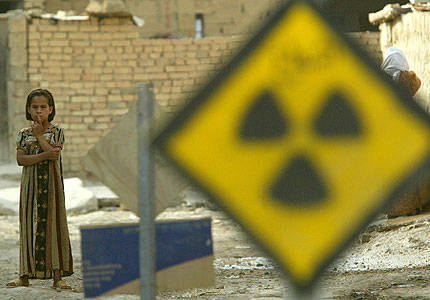
The smaller nuclear weapons become, the more likely they are to be used in areas of conflict such as Iraq
'Usable' nukes
In the past five years the US military has developed an aggressive new nuclear doctrine: military documents such as 2002's Nuclear Posture Review and the 2005 Pentagon paper Doctrine for Joint Nuclear Operations revealed that that nukes may be used as 'weapons of first resort' as well as being integrated with conventional forces.
In order to implement this policy, the US military are keen to develop a new generation of smaller, more 'useable' nuclear weapons -- known in Pentagon-speak as 'mini-nukes' and 'bunker-busters'.
Mini nuclear weapons
A mini-nuke is a nuclear bomb with an explosive yield of less than five kilotonnes (equal to about 5,000 tons of TNT). The official US military rationale behind developing these weapons is to allow them 'further flexibility' in more effectively deterring 'rogue' states. The danger is that these low-yield nuclear weapons blur the line between conventional and nuclear weapons, increasing the likelihood they will be used in conflict, and breaking a taboo that has been in place since their use against Japan in 1945.
Bunker busters
A bunker buster is a type of nuclear weapon specially hardened for the penetration of the earth and designed to destroy underground targets. A bunker buster would be dropped from the air -- by a B-2 aircraft for example -- and guided to a target. It would hit the ground at high speed because of the slim design and heavy weight allowing it to pierce through up to 20ft of concrete. A 'smart' fuse detonates the warhead in the underground bunker.
The rationale behind developing bunker busters is based on claims by the Bush administration that both Iran and North Korea have plans to position nuclear weapons deep inside underground bunkers.
The effects of exploding 'usable' nukes
Reports from the Arms Control Association reveal that even very low yield nukes used in this way would spread radioactive debris over a wide area. For instance, if a one-kilotonne warhead (just one thirtheenth of the yield that destroyed Hiroshima) was detonated in an underground bunker, the blast would create a crater bigger than a football field and eject more than a million cubic feet of radioactive debris, which would then be spread by the wind.
If located in an urban area, it could kill tens of thousands of innocent civilians. Bombing stockpiles of chemical or biological weapons would almost certainly spread some of these agents to surrounding areas, causing major damage to any local civilian population.
What's the state of play?
In October 2005, for the second year running, the US Congress refused to fund the 'bunker buster' project. The decision followed a request from the National Nuclear Security Administration (NNSA), the department responsible for developing and maintaining the US nuclear stockpile, and is very good news.
However, in February 2006 a disturbing report in the International Herald Tribune revealed that despite internal opposition, programmes to design other modernised, more accurate warheads are already underway. In fact, the NNSA has won initial support for a programme to research "reliable replacement warheads to sustain existing military capabilities". The Arms Control association sees this move as dangerous as it could eventually "increase the pressure to conduct nuclear explosive proof tests".
Around 100 specialists at the three US nuclear weapons laboratories - Lawrence Livermore, Los Alamos and Sandia - are already involved in a multi-million dollar project that will, within five to 10 years, escalate into a programme capable of producing designs for completely new nuclear weapons. The very close co-operation between these laboratories and Britain's Aldermaston site suggests that British nuclear scientists have contributed to the US programmes.
The US military claims that their programme is simply to ensure "the efficiency" of the US's existing nuclear arsenal - this is the usual language employed to conceal the development of new weapons. However, groups like the Arms Control Association state that the existing US stockpile has no need of being modernised and that the programme is more likely to be a method for the Bush administration to circumvent Congress' reluctance for funding the design of a new weapon.
Not only unnecessary but illegal?
Besides being dangerously destabilising to world peace, development by the US or UK of new or modified nuclear weapons would seriously threaten the Nuclear Non-Proliferation Treaty (NPT) thereby breaking the 35-year-old agreement under which all the nuclear powers pledged to disarm in return for other nations not seeking nuclear weapons. And because nuclear bunker busters and mini nukes would be classified as tactical weapons, their development would make it more difficult to encourage Russia to dispose of its own arsenal of over 4,000 warheads.
Moreover, the development of bunker busters and low-yield nuclear weapons will almost certainly lead to the resumption of underground nuclear testing in order to test them (contravening the Comprehensive Test Ban Treaty). This would overturn the eight-year-old moratorium on nuclear testing, prompting other nuclear powers to also resume testing, which would have a chilling effect on future arms control and non-proliferation efforts.

